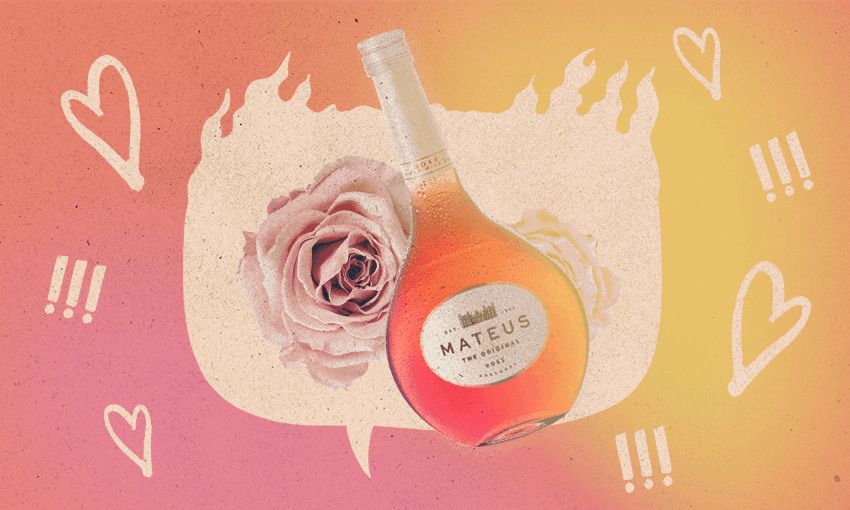Summer read: It was a 1970s dinner party staple, but these days Mateus rosé is too often overlooked. Charlotte Muru-Lanning goes in to bat for the unfairly maligned wine.
First published October 15, 2022
I’m not quite sure whether the blame lies on its rosy hue, its fizz, its rotund bottle, its inexpensiveness or its heavily retro associations, but something about Mateus inspires instant ridicule. “What is that?” my friends will undoubtedly shriek as I defiantly withdraw my chilled (and admittedly stupid-looking) bottle from the fridge.
In a world dominated by lambruscos, gamays, chilled reds, skin ferments, pet nats, piquettes, and painterly-watercolour labels, Mateus is too often the butt of the joke.
Despite this, Mateus has had some loyal fans. Jimi Hendrix was a fan, but then so was Sadam Hussein and Queen Elizabeth. And now me. All for good reason. As far as I’m concerned, it is exactly the characteristics that Mateus is derided for that in fact make it so charming.
Mateus was launched in Portugal in 1942, and according to company legend, it was the first Portuguese rosé on the market. A product of its time, the distinctive pot-bellied bottle was apparently inspired by the flask bottles of World War I soldiers. In the 1950s it was introduced internationally and as its popularity grew, it helped to cement wine as a mass-market drink. Alongside other European wines like Black Tower, Lancer’s, Cold Duck and Blue Nun, the then ornate Mateus bottle became synonymous with the idea of fine dining from the 1960s to 1980s.
Adverts for the wine at the time hinged on invocations of Portugal. Shiny-haired couples frolicked around cobbled streets sipping the wine, while a knowing voiceover proclaimed it as “the rosé wine that’s like a trip to Portugal”. Or the more questionable sales pitch, “discover the rosé wine discovered by the country that discovered the world”. It was sophisticated. It was glamorous. And there was a certain whiff of romance to it.
Sadly, Mateus’ eventually went the same way as dishes like prawn cocktail, vol au vents and aspic in the public’s eye. From polished to ostensibly passé. Throughout the 2000s, Mateus adapted through rebrands, which included dropping the word rosé (and then putting it back), trading in the opulent packaging for sleeker versions and morphing the bottle into a form that’s slimmer with a taller neck.
While Mateus has clearly persisted in sales, as evidenced by its proliferation in supermarkets and liquor stores, its reputation is decidedly low-brow. Through no fault of its own, the wine has become a rather tacky reminder of a kitschy culinary past we’d prefer to make fun of than take part in.
But everything old is new again. Political commentary is awash with observations around how eerily similar our 2022 economy is to the 1970s – the era most synonymous with Mateus’ popularity. Commodity markets disrupted by war, skyrocketing oil prices and spiking inflation, it all sounds very familiar. If we’re going to have the worst of the decade, why not bring back some of the more delightful and whimsical aspects too?
Historical analogies aside, I’ll be the first to admit that Mateus is not the best wine in the world. Not even close. Still, for a near bottom tier wine you can buy from the supermarket and most probably your closest bottle shop, it’s improbably good.
It’s sweet, but not cloyingly so, thanks to the slight fizz. With its notes of strawberry and watermelon, it’s best served crisp, meaning chilled over ice on a warm day, of which will surely become more regular as we make our way to summer.
I especially love their tiny piccolo bottles, or showing up to someone’s house with one of their gigantic magnum bottles. No matter the size though, Mateus is always a statement. And despite likely initial hesitance from those unacquainted, it’s an easy-drinking wine that tends to win people over when served in the right context: on a balmy day, preferably outdoors and with the right kind of kai.
Because of its slight sweetness, it’s a wine that lends itself especially well to food with some heat. It would work especially well to temper the spice of a chilli-laden curry, an arrabiata pasta or spicy fried chicken. I’ve always been pretty fond of a dainty glass of it to sip alongside a slice of homemade cake or a bowl of pudding as a full on embrace of the feminine. For those so inclined, I can imagine it making an excellent addition to a boozy summer fruit granita or slushy too.
To me, Mateus remains a blushing and effervescent invocation of the past. With a glass of it in hand, the future, or at least the rest of the evening, is rosy.

